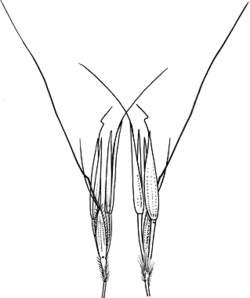Chrysopogon fallax S.T.Blake APNI* Synonyms: Chrysopogon benthamianus Henrard APNI*

Description: Erect perennial to 1.5 m high.
Leaves with sheath not keeled, with tubercle-based hairs or glabrescent, the basal sheaths persistent and disintegrating; blade incurved or loosely folded.
Panicle 7–21 cm long. Racemes mostly 1-jointed, 3.5–7 cm long. Sessile spikelet 9–11 mm long, including the callus; callus 1.7–3 mm long, with hairs to 2 mm long. Lower glume 2-keeled in the upper 30%; upper glume scabrous or the lower part smooth, the keel ± pectinate and terminating in a scabrous awn c. 5–10 mm long. Upper lemma shortly 2-lobed, 5–5.7 mm long; awn geniculate, c. 20–40 mm long, the column densely scabrous, the bristle paler, straight. Palea obtuse, 3.2–4.2 mm long. Pedicellate spikelet male or rarely sterile, acute, awned, or rarely only submuticous, subequal to the sessile spikelet, with glumes, lemmas, palea and anthers usually present. glumes, lemmas, palea and anthers usually present.
Flowering: summer.
Distribution and occurrence: Grows on heavy soils, often on floodplains.
NSW subdivisions: NT, NWS, NWP, NFWP
Other Australian states: Qld W.A. S.A. N.T.
Text by S. W. L. Jacobs & C. A. Wall
Taxon concept: Flora of NSW 4 (1993)
APNI* Provides a link to the Australian Plant Name Index (hosted by the Australian National Botanic Gardens) for comprehensive bibliographic data
***The AVH map option provides a detailed interactive Australia wide distribution map drawn from collections held by all major Australian herbaria participating in the Australian Virtual Herbarium project.
|


